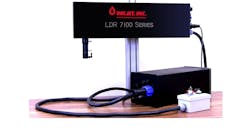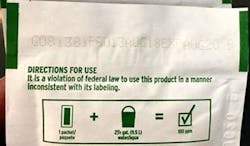Benefits of Next-Gen Digital Lasers over Scribing Lasers
Food, beverage and other consumer packaged goods (CPG) companies have been using laser technology solutions since the 1970s to address their marking and coding needs. Over the last several decades, scribing lasers have historically been used more commonly for these applications.
Carbon dioxide Transversely Excited Atmospheric (CO2 TEA) lasers were the first to be used for marking and coding applications; however, this type of laser was not easily adaptable for supporting the marking and coding needs for the food, beverage and consumer packaging industry. A TEA laser is a gas laser energized by a high voltage electrical discharge in a gas mixture generally at or above atmospheric pressure. The most common types are carbon dioxide lasers and excimer lasers, both used extensively for industrial marking and research purposes. The CO2 TEA laser was invented in the late 1960s by Dr. Jacques Beaulieu working at the Defence Research Establishment, Valcartier, in Quebec, Canada. (Source: Wikipedia)
After trying CO2 TEA lasers, packaged goods makers turned to digital lasers, then vector lasers, which are also commonly referred to as scribing lasers. Scribing lasers use a computer to control the positioning of high speed lasers to mimic writing as one would with an ink pen. This type of laser is somewhat reliable, however, can be very complicated to use: scribing lasers use a single laser to make characters and can mark or code on most common packaging materials. Additionally, scribing lasers require ample space and tend to cost in the $25,000 to $30,000 range.
Laser technology is advancing again because of people like Dr. Lee Sutter of Directed Photonics, Inc. Dr. Sutter invented the concept of a multi-laser marking system in 1984. Several generations of technology built around this concept were the first and the best laser marking units utilized in industry. The most recent innovation is the LDR 7100, an all-digital laser coder that provides reliable, Digital Resolution codes at speeds that outperform scribing lasers.
Research and Development
Directed Photonics, Inc. was established for the sole reason of producing the LDR 7100 industrial laser printer and bringing this advanced solution to the marketplace through authorized distributors.
The LDR 7100 was beta-tested at a global manufacturer of plastic bottles in the Midwest Region of the United States for two years, running continuously in production on one of this company’s PET (polyethylene terephthalate) bottle production lines. The production line produces 65,000 PET bottles per hour 24/7. Roughly 500,000 marks per day were reliably produced by the LDR on this production line. There were no failures of the unit or any of the components of the LDR unit during this test period. Several improvements to the laser radio frequency (RF) power supply were incorporated to make the lasers more robust and resistant to heat. Software and firmware upgrades were also made to the LDR at the suggestion of Amcor plant engineering and maintenance personnel at this location. Although many of the requested improvements to the programming were unique to the needs of this facility, some of the suggested changes proved to be beneficial to all users of the system. This example is indicative of the nature of testing a unit in actual production. These suggestions were easily incorporated into the LDR unit with changes in the operating application or the firmware and, thus, have become permanent upgrades.
Directed Photonics has found that listening to engineers, line operators and plant maintenance personnel in the field through this beta test and through trials is the most effective approach to ensuring that the laser marking system fulfills the needs of end users for the long-term customer.
Technological Advantages
The LDR 7100’s innovative design with point-and-shoot installation and operation make it easy to operate and install. Additionally, LDR 7100 systems can operate as stand-alone units or they can be integrated with other mainframe/enterprise systems, Programmable Logic Controllers (PLCs) or other devices. Plug-and-play laser modules make switching out tubes fast and easy. Users can also intuitively enter messages and control the system via an app on their computer, tablet or smartphone. The LDR 7100’s unique no galvos technology results in a stable, modular design. The absence of moving parts increases uptime and significantly decreases repair times (for example, users can change a tube in 30 seconds). In addition, controlling the system via computer, tablet or smartphone app eliminates the control cabinet, thus aiding in the low profile and machine footprint.
The LDR 7100 was designed for longevity and durability, featuring multiple simple cooling options, including efficient closed-loop cooling for high duty-cycle applications and a sturdy IP65 rated cabinet design. The cost of the LDR 7100 not only has an initial lower capital cost than scribing lasers currently on the market (approximately 50% lower), but minimized maintenance and downtime contribute to a considerable lower cost of ownership.
Field Testing
Testing of this innovative industrial laser marking system is underway at two U.S.-based facilities. These end users are working with the developer and authorized distributor with the understanding that they will deliver feedback that will be useful for all parties involved. Plant personnel are finding that the system is easy to install and to incorporate into their packaging and production processes. With no galvos, which means no moving parts to wear out or repair, the LDR 7100 is proving that it can withstand harsh manufacturing environments (i.e., heat, dust and moisture issues, among others) with its true IP65 system rating, closed loop water cooling and gun metal anodized cabinet.
A trial period of 60 days to 6 months is recommended to assess overall performance improvements over scribing printers.
For a complimentary consultation and to discuss the feasibility and timing of a trial, please go to www.inkjetinc.com/laser.
About the Author
Bill Allen
Marking and Coding Specialist
Bill Allen is a Marking and Coding Specialist with InkJet, Inc. who also serves as the company’s National Sales Director. He joined InkJet, Inc. in 2014. Connect with Mr. Allen on Linked In or via email: [email protected].


